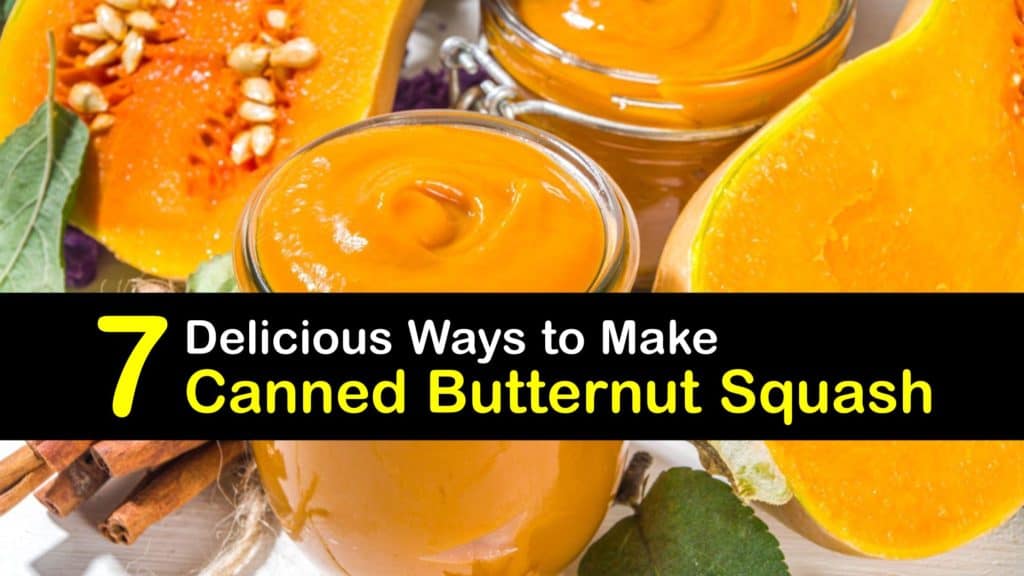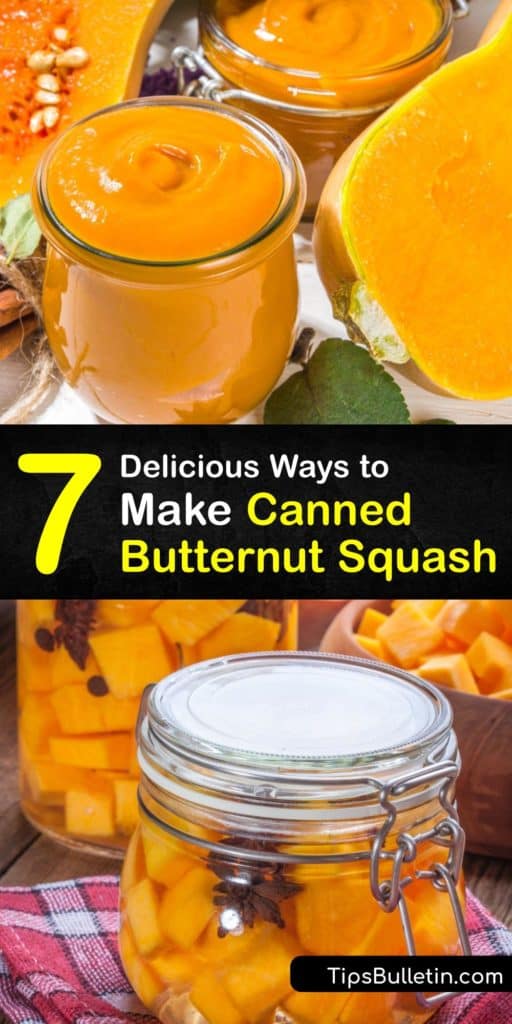We love harvesting fresh veggies and squash from the garden, and there is nothing better in the winter pantry than shelves stocked with canned pumpkin, squash puree, and butternut squash soup. While canning butternut squash takes a bit of preparation and know-how, it’s a relatively simple process if you have all the right equipment.
Butternut squash is an easy winter squash to peel and cube, so it’s one of the most popular for home canning and food preservation.
Use the puree as a replacement for pumpkin pie, cubed squash for roasting, and roasted butternut squash seeds are one of our favorite snacks.
While butternut squash has a hard rind and a long storage life, it doesn’t last indefinitely, and cooked squash only stays fresh three to five days in the refrigerator.
A pressure canner comes in handy since unopened canned butternut squash lasts many years under the proper storage conditions.

Ways to Can Butternut Squash
Explore our complete guide to canning butternut squash with a variety of recipes. Learn the tools and equipment necessary for home canning and some tasty butternut squash recipes.
How Long does Canned Butternut Squash Last?
Butternut squash is one of the more popular and tasty types of gourds and squash. There are many good reasons to make canned butternut squash, and one of them is for food storage purposes. How long does squash last after canning whole butternut squash?
The answer depends on how you can the squash. While water bath canning butternut squash or water bath canning spaghetti squash is not recommended, pressure canning, quick pickling, and freezing butternut squash are good alternatives.
Water bath canning is a popular way to can many foods. However, low-acid foods may contain clostridium botulinum bacteria, which survives in boiling water and grows in sealed jars, leading to the deadly botulinum toxin.

According to the USDA, it’s vital to can foods like poultry, red meats, fish, and most vegetables in a pressure cooker to prevent botulism.
Fortunately, the extra effort goes a long way since pressure canned butternut squash lasts three to five years unopened.
If you lack the patience or the equipment to pressure can your squash, it’s safe to pickle it for refrigeration storage. However, refrigerator pickles only last up to two months.
Canning Butternut Squash Cubes
If you enjoy making roasted butternut squash, cubing the squash for canning ensures that you have plenty on hand for your favorite roasting recipes. Here is how to prepare and can cubed squash for convenient storage.
Wash, peel, seed, and cut the butternut squash into 1-inch cubes. Blanch the cubed squash in boiling water for two minutes and pack them in quart-sized jars, leaving an inch of headspace.
Top them off with boiling water while maintaining the headspace, remove the air bubbles, wipe the jar rims, and put the lids in place.
Place the jars in a pressure canner with ten pounds pressure with a weighted gauge and eleven pounds for a dial gauge. Process the jars for 90 minutes. If you can your squash in pint-sized jars, process them for 55 minutes.
How to Can Butternut Squash Soup
There is nothing more comforting than a bowl of homemade soup on a cold winter’s day, and butternut squash is an excellent choice for making and canning soup. Here is how to can butternut squash soup using a basic recipe.
Start by cutting the squash into one-inch chunks and then blanch them in boiling water for two minutes.
Remove the squash from the hot water, cool it in a bowl of ice water, and then place the cooled squash into a bowl with the chopped onion, celery, carrots, apples, and garlic cloves.
Stir the ingredients and pour them into the pint jars, leaving 1-inch headspace. Add a 1/2 teaspoon of chicken bouillon and a pinch of white pepper and ground ginger to each jar, and cover with boiling water, leaving an inch of space.
De-bubble the jars, wipe the rims and screw the caps in place. Place the jars in a simmering pressure cooker for 60 minutes of processing time.
How to Can Butternut Squash Puree
There are many reasons to have canned butternut squash puree on hand, whether you make your own baby food, use it in pies, or enjoy it as a side dish. It’s easy to prepare, and this recipe stores well in the fridge or freezer.
Slice the butternut squash lengthwise in half and remove the seeds. Place it cut-side down on a baking sheet, brush it with oil, and roast it in the oven heated to 400°F for 45 minutes, or until tender.
Remove the squash from the heat and allow it to cool before scraping the pulp into a food processor.
Puree the squash until smooth, and strain it through cheesecloth into canning jars. How long does a butternut squash last after pureeing? Keep the jars in the fridge for seven to ten days or freeze them for up to six months.
Easy Way to Make Quick Pickled Butternut Squash
If the thought of pressure canning butternut squash seems intimidating, but you are still eager to can butternut squash, making a batch of pickled squash might be what you’re looking for.
Here is how to can butternut squash with a quick-pickling technique for short-term storage.
Pour the cubed butternut squash into a bowl, toss with salt, and let it sit at room temperature for four hours. Drain and rinse the veggies, squeeze out the excess moisture, and set them aside.
Mix all ingredients except the squash in a pot and bring it to a boil over medium-high heat to dissolve the sugar. Add the squash and bring it back to a simmer before removing the pot from the heat.
Pour the pickled squash and cooking liquid into a quart-sized jar and let it cool to room temperature before screwing the lid in place and storing it in the refrigerator.
Using Canned Pureed Squash to Make Pie
What better way to use up those cans of pureed butternut squash than to make pie? This recipe substitutes butternut squash puree for pumpkin puree, and the result is delicious.
Place one pre-made pie crust into a nine-inch pie pan and set it in the fridge to chill while you prepare the filling. Whisk the eggs in a bowl until frothy and stir in the sugar, vanilla extract, spices, and salt.
Fold in the butternut squash puree and pour the mixture into the chilled pie crust. Set the pie pan on a baking sheet to catch spills and bake it in an oven heated to 375°F for 45 to 50 minutes.
How to Make Roasted Butternut Squash Seeds
If you’ve ever had roasted pumpkin seeds, then you’re bound to love roasted butternut squash seeds. Instead of tossing the seeds in the trash while preparing the squash for canning, roast them for a healthy and tasty snack.
Toss the butternut squash seeds with olive oil and salt to taste in a bowl while the oven preheats to 325°F. Consider personalizing the seeds with your own spices, such as Cajun, garlic, or chili powder.
Spread the seasoned seeds on a cooking sheet and roast them in the oven for about fifteen minutes, stirring them halfway through the cooking time. Let them cool and enjoy.
While canning with a water bath canner is the easiest canning method, low-acid foods require special care, and a pressure cooker is necessary for preserving butternut squash.
Fortunately, it’s easier than you think if you have the proper equipment and follow the right canning steps.

Canning butternut squash is fun, rewarding, and a great way to keep your pantry well-stocked with tasty butternut squash recipes, so why not share our butternut squash canning tips with your family and friends on Facebook and Pinterest?